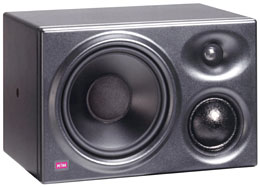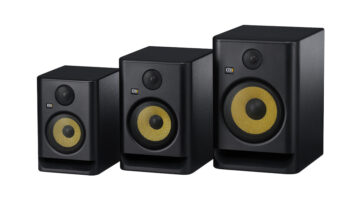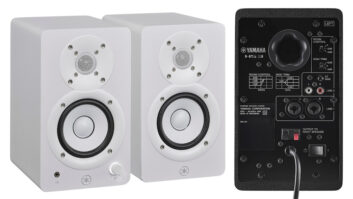
It wasn’t long ago that active monitors were the exception in studios rather than the norm. Part of the popularity of self-powered speakers can be linked to shrinking control rooms and surround mixing, where having six speakers and amps, plus a bunch of cables becomes unwieldy. Addressing these issues, Klein + Hummel manufactures active monitors for studio use. The O 300s ($6,995/pair) reviewed here fall in the middle of the company’s line; a version with digital inputs (the O 300 D) is also available.
THE STORY OF O
Though housed in an ordinary-looking cabinet finished in gray paint, the O 300 is anything but run-of-the-mill. The speaker is mag-shielded so nearby video monitors are safe, and the front baffle is sculpted with a high-frequency waveguide to control tweeter dispersion. The O 300 has an 8-inch woofer, 3-inch midrange and a 1-inch titanium-dome tweeter.
Power is supplied by three internal amps delivering 150, 65 and 65 watts RMS for the bass, mid and HF driver, respectively. Crossover frequencies are spec’d at 650 Hz and 3.3 kHz — well out of the critical vocal range. A red, backlit K+H logo on the front panel indicates when the speaker is on. Rear panel controls include an on/off switch, fuse and AC power inlet; balanced XLR input with attenuator; and switches for bass, low-mid and high contour.
IT’S A SETUP
I set up the O 300s where I normally place my Westlake Lc 8.0 monitors: on Auralex MoPADs on a shelf well above the meter bridge, roughly four feet apart and equally as far from the mix position. I used Mogami cable to connect the O 300s to a Tascam DM3200, and I set the input attenuators to 0. When the O 300s arrived, I jumped right into mixing the upcoming CD Seas of Blood from Portland, Maine — based goth/metal band By Blood Alone.
The first thing I noticed about the O 300s is that they present an incredible sense of depth. Many monitors throw a wide left-to-right image, but few allow you to hear into a mix. The O 300s really let you hear front-to-back position and help you easily place elements into a mix while producing a smooth, natural and uncolored response. After doing a few rough mixes, lead guitarist John Graveside and I burned some CDs and checked our mixes on a variety of audio systems (cars, home hi-fis, headphones, etc.). We observed that the mixes were light in the low end — exactly what I expected, given the fact that the monitors were within a foot of the rear wall. (I did not want to use the O 300s’ EQ before hearing their unmodified response or finding out how they reacted with the room.) The O 300s’ bass response was being bumped up due to its room placement; when we took the mixes elsewhere, there was not enough bass.
Enter the rear panel EQs. These recessed rotary switches compensate for the O 300s’ response — especially useful in small control rooms where a free-field placement (i.e., on stands, several feet from the nearest boundaries) is impractical. Options include 0, -3, -6 and -9 for bass; +2, 0, -2 and -4 dB for low-mid; and +2, +1, 0 or -2 dB for the HF driver. K+H did its homework when designing these controls. In the case of the bass control, these values coincide with the nature of acoustics: Place a speaker near a wall, and you’ll get a 3dB bump in the bottom end; place it in a corner, and you’ll get a 6dB bump; in a corner near a ceiling or floor, and your bass response is exaggerated by 9 dB.
Changing the bass EQ to -3 dB did the trick, keeping the bass response tight in the control room and providing balanced mixes wherever we listened. Because the console was approximately 18 inches below the bottom of the O 300 cabinets, we didn’t need the low-mid EQ, which is designed for situations where console reflections can exaggerate the low-mid response, or the HF control, which compensates for bright- or dull-sounding rooms.
In addition to mixing, I also tracked drums, bass and keys with the O 300s. Though the two are not mutually exclusive, many monitors that work well for mixing do not have what I call the “ruthlessness factor” for tracking (i.e., they are not revealing enough). The O 300s excel at both. Signal anomalies, such as a squeaky hi-hat stand were clearly exposed, as were extraneous lip noises on vocal tracks and very low-level guitar buzzes. The O 300s are capable of effortlessly producing SPLs approaching the mid-100dB level (higher than I’d care to listen to) with a bottom end that is clean, tight and extended — though it may not bring the walls down. (K+H offers the optional O 800 and O 900 subwoofers for that.)
HONESTLY, I WANT THESE
Klein + Hummel O 300s are among those rare speakers that are transparent enough to let you know exactly what you are recording and yet somehow translate mixes very well. In the process, the O 300s are honest without causing fatigue — even after doing countless 10 to 14-hour sessions. Granted, at $6,995/pair, the O 300s are not cheap, but they definitely rise to the top of the monitor food chain. I am not looking forward to returning them.
Klein + Hummel, dist. by Sennheiser, 860/434-9190, www.klein-hummel.com, www.sennheiserusa.com.
Steve “Woody” La Cerra is Mix’s sound reinforcement editor.







